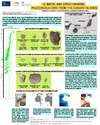Please use this identifier to cite or link to this item:
https://accedacris.ulpgc.es/jspui/handle/10553/11862
| Title: | Climatic and stratigraphic paleoindicators from the Canary Island | Authors: | Betancort-Lozano, Juan Francisco Lomoschitz, Alejandro Coca, Josep Redondo, Alexandre Montesinos del Valle, Mercedes Ramos, Antonio G. Meco, J. |
UNESCO Clasification: | 240119 Zoología marina | Keywords: | Paleoindicators, Neogene, M.I.S. 11, M.I.S. 5.5, SST, Clo-a, Gulf of Guinea | Issue Date: | 2014 | Abstract: | The last 5 Myr are characterized by cliamatic variations globally and are reflected in ancient fossiliferous marine deposits visible in the Canary Islands. The fossils contained are identificated as paleoecological and paleoclimatic indicators. The Mio-Pliocene Transit is represented by the coral Siderastrea micoenica Osasco, 1897; the gastropods Rothpletzia rudista Simonelli, 1890; Ancilla glandiformis (Lamarck, 1822); Strombus coronatus Defrance, 1827 and Nerita emiliana Mayer, 1872 and the bivalve Gryphaea virleti Deshayes, 1832 as most characteristic fossils and typical of a very warm climate and littoral zone. Associated lava flows have been dated radiometrically and provides a range between 8.9 and about 4.2 Kyr. In the mid-Pleistocene, about 400,000 years ago, the called Marine Isotope Stage 11, a strong global warming that caused a sea level rise happens. Remains of the MIS 11 are preserved on the coast of Arucas (Gran Canaria), and associated with a tsunami in Piedra Alta (Lanzarote). These fossilifeorus deposits contains the bivalve Saccostrea cucullata (Born, 1780), the gastropod Purpurellus gambiensis (Reeve, 1845) and the corals Madracis pharensis (Heller, 1868) and Dendrophyllia cornigera (Lamarck, 1816). Both sites have been dated by K-Ar on pillow lavas (approximately 420,000 years) and by Uranium Series on corals (about 481,000 years) respectively. The upper Pleistocene starts with another strong global warming known as the last interglacial or marine isotope stage (MIS) 5.5, about 125,000 years ago, which also left marine fossil deposits exposed in parallel to current in Igueste of San Andrés (Tenerife), El Altillo, the city of Las Palmas de Gran Canaria and Maspalomas (Gran Canaria), Matas Blancas, the Playitas and Morrojable (Fuerteventura ) and in Playa Blanca and Punta Penedo (Lanzarote ). The fossil coral Siderastrea radians (Pallas , 1766 ) currently living in the Cape Verde Islands , the Gulf of Guinea and the Caribbean has allowed Uranium series dating. The gastropods Strombus bubonius Lamarck, 1822 and Harpa doris (Röding , 1798 ) currently living in the Gulf of Guinea. Current biogeography using synoptic data obtained through satellites provided by the ISS Canary Seas provides data of Ocean Surface Temperature (SST) and Chlorophyll a (Chlor a) . This has allowed the estimation of these sea conditions during interglacials compared to today . Los últimos 5 Ma se caracterizan por las variaciones climáticas a escala global y han quedado reflejados en antiguos depósitos marinos fosilíferos visibles en las Islas Canarias. Los fósiles que contienen son indicadores paleoecológicos y paleoclimáticos. El tránsito mio-plioceno está representado por el coral Siderastraea micoenica Osasco, 1897; los gasterópodos Rothpletzia rudista Simonelli, 1890; Ancilla glandiformis (Lamarck, 1822); Strombus coronatus Defrance, 1827; Nerita emiliana Mayer, 1872 y el bivalvo Gryphaea virleti Deshayes, 1832 como fósiles más característicos y propios de un clima muy cálido y de la zona litoral. Las lavas asociadas han sido datadas radiométricamente entre unos 8.9 Ma y unos 4.2 Ma. En el Pleistoceno medio, hace unos 400.000 años, el llamado estadio isotópico marino (M.I.S.) 11, se produce un fuerte calentamiento global que provocó una elevación del nivel del mar cuyos restos se conservan en la costa de Arucas (Gran Canaria) y, asociados a un tsunami, en Piedra Alta (Lanzarote). Contienen el bivalvo Saccostrea cucullata (Born, 1780); el gasterópodo Purpurellus gambiensis (Reeve, 1845) y los corales Madracis pharensis (Heller, 1868) y Dendrophyllia cornigera (Lamarck, 1816). Ambos yacimientos han sido datados, por K-Ar sobre pillow-lavas (unos 420.000 años) y el por Series de Uranio sobre corales (unos 481.000 años) respectivamente. El Pleistoceno superior se inicia con otro fuerte calentamiento global conocido como último interglacial o estadio isotópico marino (M.I.S.) 5.5, hace unos 125.000 años, que también dejó expuestos sus depósitos marinos paralelamente a las actuales costas canarias en Igueste de San Andrés (Tenerife), en El Altillo, la ciudad de Las Palmas y Maspalomas (Gran Canaria), en Matas Blancas, las Playitas, y Morrojable (Fuerteventura) y en Playa Blanca y Punta Penedo (Lanzarote). El coral fósil Siderastraea radians (Pallas, 1766) que vive actualmente en las islas de Cabo Verde, las costas del Golfo de Guinea y en el Caribe ha permitido la datación por series de Uranio. Los gasterópodos Strombus bubonius Lamarck, 1822 y Harpa doris (Röding, 1798) viven actualmente en las costas del Golfo de Guinea. La biogeografía actual usando datos sinópticos obtenidos por medio de satélites artificiales proporcionados por la Estación Espacial Seas Canarias permite obtener datos de Temperatura Superficial del Océano (SST) y de Clorofila a (Clor a). Esto ha permitido la estimación de estas condiciones del mar durante los interglaciales por comparación con las actuales. |
URI: | https://accedacris.ulpgc.es/handle/10553/11862 | Source: | Book of Abstracts submitted to the IV Congress of Marine Sciences (Las Palmas de Gran Canaria, June 11th to 13th). 488 p. ISBN 84-697-0471-0 / ISBN 978-84-697-0471-4 |
| Appears in Collections: | Póster de congreso |
This item is licensed under a Creative Commons License

